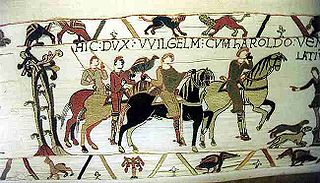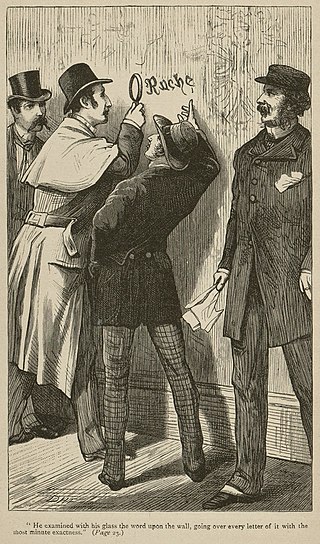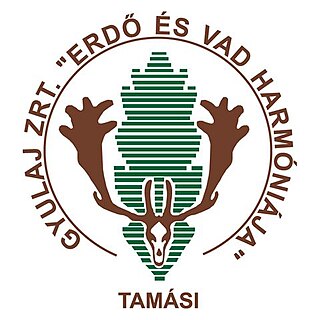
Hunting is the human practice of seeking, pursuing, capturing, and killing wildlife or feral animals. The most common reasons for humans to hunt are to obtain the animal's body for meat and useful animal products, for recreation/taxidermy, although it may also be done for resourceful reasons such as removing predators dangerous to humans or domestic animals, to eliminate pests and nuisance animals that damage crops/livestock/poultry or spread diseases, for trade/tourism, or for ecological conservation against overpopulation and invasive species.

Fox hunting is an activity involving the tracking, chase and, if caught, the killing of a fox, normally a red fox, by trained foxhounds or other scent hounds. A group of unarmed followers, led by a "master of foxhounds", follow the hounds on foot or on horseback.
A snipe hunt is a type of practical joke or fool's errand, in existence in North America as early as the 1840s, in which an unsuspecting newcomer is duped into trying to catch an elusive, nonexistent animal called a snipe. Although snipe are an actual family of birds, a snipe hunt is a quest for a creature whose description varies.

The white-tailed deer, also known commonly as the whitetail and the Virginia deer, is a medium-sized species of deer native to North America, Central America, and South America as far south as Peru and Bolivia, where it predominately inhabits high mountain terrains of the Andes. It has also been introduced to New Zealand, all the Greater Antilles in the Caribbean, and some countries in Europe, such as the Czech Republic, Finland, France, Germany, Romania and Serbia. In the Americas, it is the most widely distributed wild ungulate.

Drag hunting or draghunting is a form of equestrian sport, where mounted riders hunt the trail of an artificially laid scent with hounds.
Ole and Lena are central characters in jokes by Scandinavian Americans, particularly in the Upper Midwest region of the United States. These include the Upper Peninsula of Michigan, Minnesota, Wisconsin, Iowa, South Dakota and North Dakota, where Scandinavian immigrant traditions are common.

Royal hunting, also royal art of hunting, was a hunting practice of the aristocracy throughout the known world in the Middle Ages, from Europe to Far East. While humans hunted wild animals since time immemorial, and all classes engaged in hunting as an important source of food and at times the principal source of nutrition, the necessity of hunting was transformed into a stylized pastime of the aristocracy. In Europe in the High Middle Ages the practice was widespread.

A red herring is something that misleads or distracts from a relevant or important question. It may be either a logical fallacy or a literary device that leads readers or audiences toward a false conclusion. A red herring may be used intentionally, as in mystery fiction or as part of rhetorical strategies, or may be used in argumentation inadvertently.
Hunting strategy or hunting method is any specific techniques or tactics that are used to target, pursue, and hunt an animal. The term mostly applies to humans catching and killing wild animals, but can also be used in ethology and nature documentaries to describe predation strategies adopted by carnivores.

Tracking in hunting and ecology is the science and art of observing animal tracks and other signs, with the goal of gaining understanding of the landscape and the animal being tracked. A further goal of tracking is the deeper understanding of the systems and patterns that make up the environment surrounding and incorporating the tracker.

The Boone and Crockett Club is an American nonprofit organization that advocates fair chase hunting in support of habitat conservation. The club is North America's oldest wildlife and habitat conservation organization, founded in the United States in 1887 by Theodore Roosevelt and George Bird Grinnell. The club was named in honor of hunter-heroes of the day, Daniel Boone and Davy Crockett, whom the club's founders viewed as pioneering men who hunted extensively while opening the American frontier, but realized the consequences of overharvesting game. In addition to authoring a famous "fair chase" statement of hunter ethics, the club worked for the expansion and protection of Yellowstone National Park and the establishment of American conservation in general. The club and its members were also responsible for the elimination of commercial market hunting, creation of the National Park and National Forest Services, National Wildlife Refuge system, wildlife reserves, and funding for conservation, all under the umbrella of what is known today as the North American Model of Wildlife Conservation.

Big Buck Hunter is a game hunting video game developed by Play Mechanix. Primarily developed for arcades, the goal of the game is to shoot moving bucks or male animals without shooting a doe or female animal.

Deer hunting is hunting deer for meat and sport, and, formerly, for producing buckskin hides, an activity which dates back tens of thousands of years. Venison, the name for deer meat, is a nutritious and natural food source of animal protein that can be obtained through deer hunting. There are many different types of deer around the world that are hunted for their meat. For sport, often hunters try to kill deer with the largest and most antlers to score them using inches. There are two different categories of antlers. They are typical and nontypical. They measure tine length, beam length, and beam mass by each tine. They will add all these measurements up to get a score. This score is the score without deductions. Deductions occur when the opposite tine is not the same length as it is opposite. That score is the deducted score.

In medieval and Early Modern England, Wales and Ireland, a deer park was an enclosed area containing deer. It was bounded by a ditch and bank with a wooden park pale on top of the bank, or by a stone or brick wall. The ditch was on the inside increasing the effective height. Some parks had deer "leaps", where there was an external ramp and the inner ditch was constructed on a grander scale, thus allowing deer to enter the park but preventing them from leaving.

A hart is a male red deer, synonymous with stag and used in contrast to the female hind; its use may now be considered mostly poetic or archaic. The word comes from Middle English hert, from Old English heorot; compare Frisian hart, Dutch hert, German Hirsch, and Swedish, Norwegian, and Danish hjort, all meaning "deer". Heorot is given as the name of Hrothgar's mead hall in the Old English epic Beowulf.
A limer, or lymer, was a kind of dog, a scenthound, used on a leash in medieval times to find large game before it was hunted down by the pack. It was sometimes known as a lyam hound/dog or lime-hound, from the Middle English word lyam, meaning 'leash'. The French cognate limier has sometimes been used for the dogs in English as well. The type is not to be confused with the bandog, which was also a dog controlled by a leash, typically a chain, but was a watchdog or guard dog.

Cabela's Outdoor Adventures is a hunting video game released only in North America on September 8, 2009 by Activision for home consoles, and on October 13, 2009 for Microsoft Windows.

Gyulaj Forestry and Hunting Private Limited Company is one of Hungary's 22 state owned forestry and hunting companies. Its online marketing brand name is Gyulaj Hunting Hungary. Besides forest management one of its main business activities is big game management carried out in professional and traditional near- nature way. Its game management branch activities include receiving international hunting clients for purpose of hunting for local big game species. Its business premises are located in Tamási, South- West Hungary in Tolna County. Among the Hungarian state-owned forestries Gyulaj Plc is the leader by its highest rate of incomings from hunting section compared to the total annual incomings of the company. By this performance Gyulaj Forestry and Hunting Plc is a key player of the Hungarian big games management and hunting. Its legal predecessors and different hunting grounds look back at a rich hunting history and performance: a heritage that has been kept alive until today. Gyulaj Forestry and Hunting Plc has been operating in the legal form of a private limited company since November 3, 2005. With its center in Tamási it presently does forest management on nearly 23,500 hectares state forestland and quality game management on nearly 30,000 hectares in South-West Hungary.

Cecil was a male African lion who lived primarily in the Hwange National Park in Matabeleland North, Zimbabwe. He was being studied and tracked by a research team of the University of Oxford as part of a long-term study.

A fool's errand prank is a type of practical joke where a newcomer to a group, typically in a workplace context, is given an impossible or nonsensical task by older or more experienced members of the group. More generally, a fool's errand is a task almost certain to fail.
















